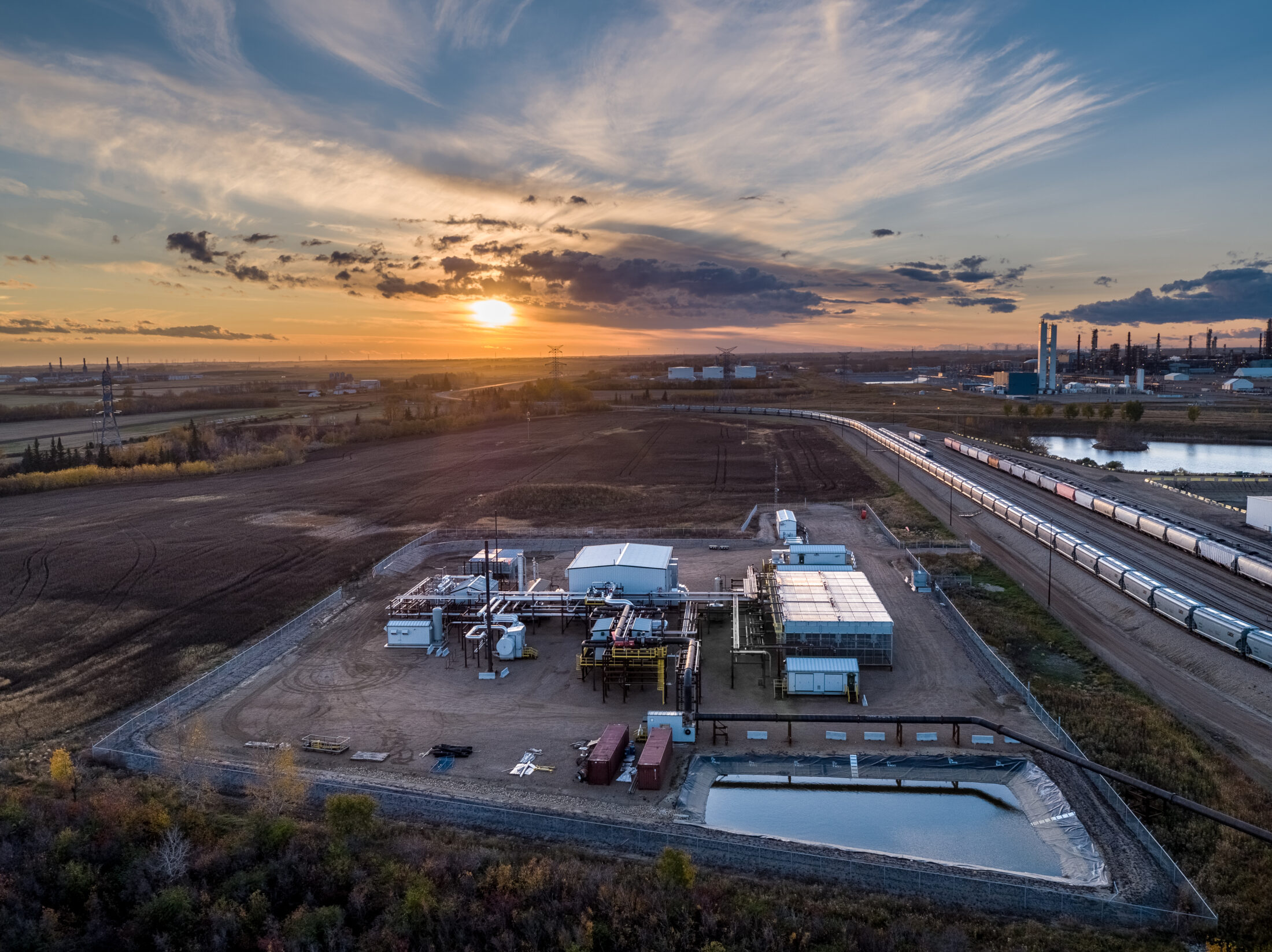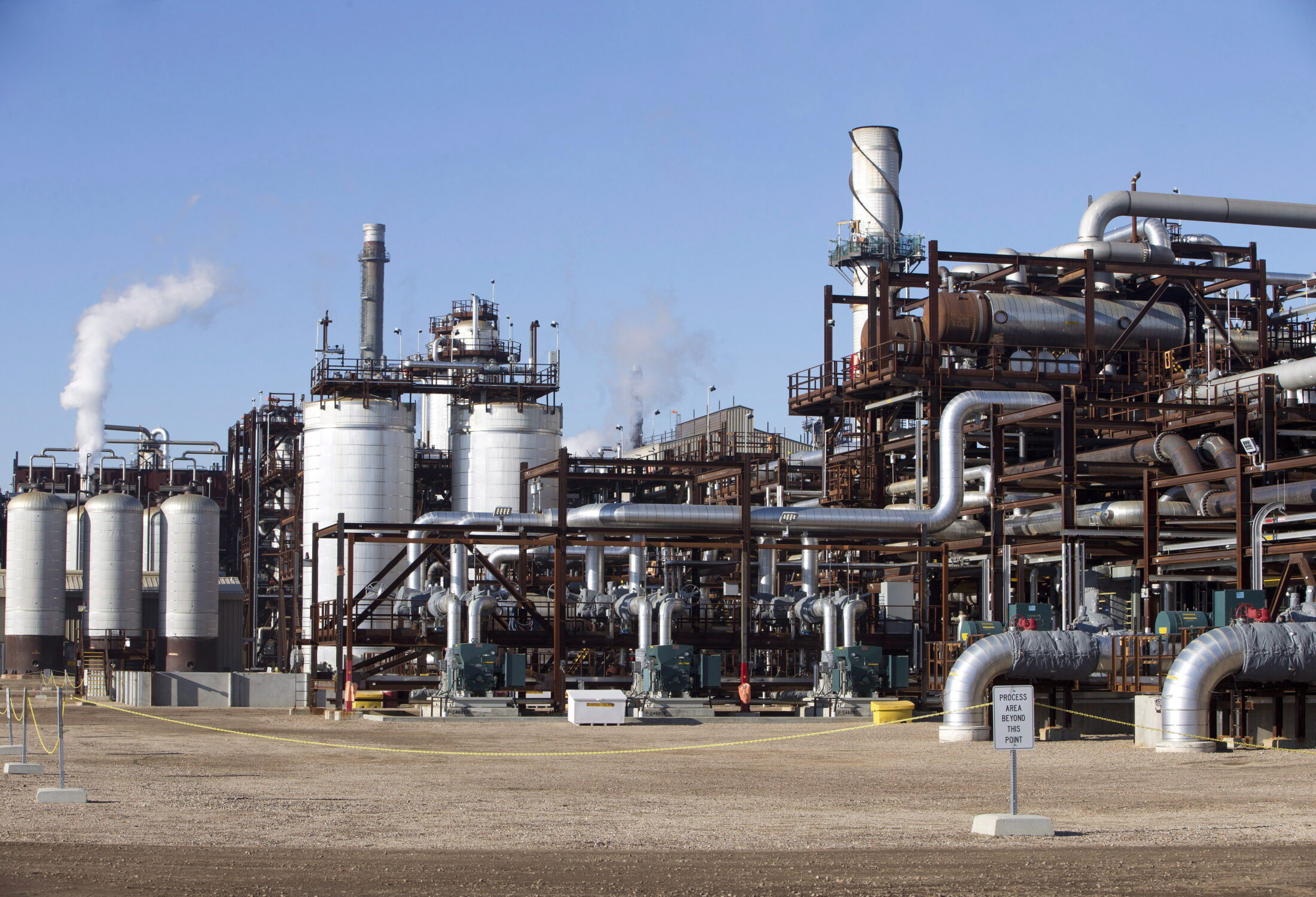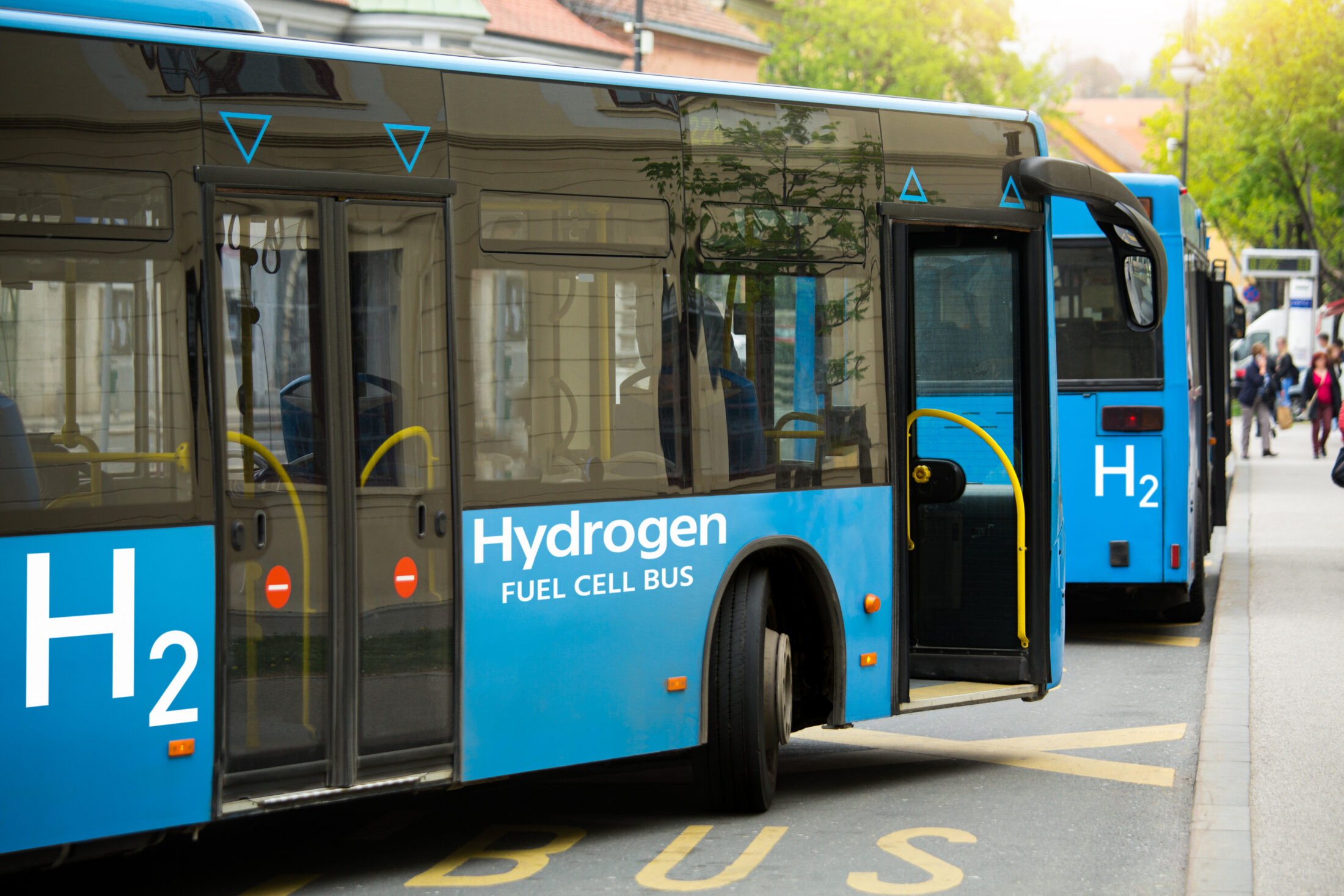
The site of an infamous B.C. mining disaster could get even bigger. This First Nation is going to court — and ‘won’t back down’
Xatśūll First Nation is challenging B.C.’s approval of Mount Polley mine’s tailings dam raising. Indigenous...
It’s been called a “$100 billion opportunity” for Alberta, “a game changer for Albertans” and it’s estimated this new industry could supply nearly a fifth of global energy demand.
In short, there’s a lot of buzz about hydrogen on the Prairies.
The element, part of every molecule of water and the most ubiquitous element on the planet, has been gaining attention as of late, with increasing calls for it to play a central role in a net-zero economy.
Here’s how hydrogen works: once pure, hydrogen can be burned as a fuel, not unlike natural gas. In this case, it is “burned” by combining it with oxygen, which releases energy, emitting only one thing in the process: water. Hydrogen can also be used to create electricity in hydrogen fuel cells, which share similarities with batteries, but don’t need recharging. Many hydrogen proponents argue the element can displace fossil fuels in sectors for which electrification is difficult.
While hydrogen does not release carbon pollution when burned, the capacity for this fuel to play a major role in a net-zero economy depends on how it’s produced — whether it’s made from water, using electrolysis fueled by renewable electricity, or generated from fossil fuels.
“The world is in a hydrogen fervour,” Dan Wicklum, president and CEO of the Transition Accelerator, a Canadian charity advocating for “transformational change,” says on a video call.
The Government of Canada released a hydrogen strategy in December, suggesting “rapid expansion” would “[position] Canada to become a world-leading supplier of hydrogen technologies.” Hydrogen, it noted, could play a key role in helping Canada to meet its obligation to achieve net-zero emissions by 2050.
And Edmonton, right in the middle of Alberta’s industrial heartland, has been pegged as a leader in the charge.
It’s what Mark Kirby, president and CEO of the Canadian Hydrogen and Fuel Cell Association, hopes will “position Alberta as a clean hydrogen powerhouse.”
Plans are in the works to transform parts of the industrial region in the Edmonton area to a leaping-off point for a new hydrogen fuel economy.
On Wednesday, the Transition Accelerator held a virtual press conference to announce new funding for a “hydrogen hub” from the federal and provincial governments. Minister Jim Carr, Prime Minister Justin Trudeau’s special representative for the prairies, announced $1.2 million in funding to the Transition Accelerator to build on its plans to create “a first of its kind” hydrogen hub in the Edmonton area.
At the same time time, Alberta’s Associate Minister of Natural Gas and Electricity, Dale Nally, announced the provincial government would be providing $450,000 to the project, which he dubbed as critical to expanding the production and use of hydrogen as a “clean, affordable energy source.”
But the verdict is still out on whether a hydrogen economy in Alberta would truly be “clean.”
“There are many caveats,” says Simon Dyer, deputy executive director of the Pembina Institute. “There are places where it has potential and there are places where it doesn’t make sense. It very much depends on the carbon emissions profile.”
Right now, Alberta’s sights are set on using natural gas to generate hydrogen — a plan in which any climate benefits rest entirely on carbon capture and storage, a technology that has so far relied on hundreds of millions in government funding.

So-called blue hydrogen is produced from fossil fuels, namely natural gas, and paired with robust carbon capture technologies. The Redwater Carbon Recovery Facility is already up and running in Alberta, though carbon capture in the province has so far been reliant on government funding to get its start. Photo: Alberta Carbon Trunk Line
The prospect of a transition to a hydrogen economy is what could be considered a pragmatic approach in the province home to the bulk of Canada’s fossil fuel production.
Alanna Hnatiw, mayor of Sturgeon County, located north of Edmonton, says hydrogen could help “insulate the market here away from the winds of the global economy.”
Proposals range from blending hydrogen with natural gas in home-heating systems to converting municipal fleets — from garbage trucks to buses — from diesel to hydrogen.
“We’re prepared to bend over backwards to be a lab for innovation.”
“I would love for Edmonton to be the place where we innovate that technology, test that technology, prove that technology and help scale it to the world,” Don Iveson, the mayor of the City of Edmonton, told The Narwhal in an interview.
“We’re prepared to bend over backwards to be a lab for innovation.”
Hnatiw sees the region as ideally suited to producing, exporting and utilizing hydrogen, especially given the skillsets of many workers in the region. But building demand, she said, is as essential as scaling up production.
“It can’t happen soon enough,” she said.

Mayor of Edmonton Don Iveson sees hydrogen as a possible way forward for a province grappling with the changes needed to address the climate crisis. “If there’s a way to bring people back into hope and back into employment in this part of the country, that would mean so much for those families, for our economy, and, frankly, for national unity,” he said, adding a hydrogen economy can use the skills of workers in the region. Photo: City of Edmonton
The use of hydrogen as a fuel — for transportation, heating, industrial applications — is an idea growing in popularity, though it has not yet taken off in a major way. According to the International Energy Agency, hydrogen has “not yet realized its potential to support clean energy transitions.”
And although hydrogen is already produced in large quantities around the world, it is not currently a clean form of energy. At least, not yet.
According to the International Energy Agency, existing global hydrogen production is responsible for annual carbon emissions equivalent to the combined total of Indonesia and the United Kingdom. “Ambitious, targeted and near-term action is needed,” it has noted, to make hydrogen a viable clean energy source.
And that’s where the idea for a hydrogen hub or node in the Edmonton region comes in. Big plans emerged last fall with the launch of Alberta’s Industrial Heartland Hydrogen Task Force, which outlined the potential for a so-called hydrogen hub or node in the Edmonton area — including the industrial heartland north and east of the city.

Alberta’s Industrial Heartland Hydrogen Task Force envisions the dramatic expansion of hydrogen, produced from fossil fuels and paired with carbon capture, in the Edmonton region. This form of hydrogen production produces significantly less carbon pollution than the burning of natural gas, but emissions are further reduced if the hydrogen is produced instead using clean electricity rather than fossil fuels. Photo: Alberta Carbon Trunk Line
According to a report from the Transition Accelerator, the area already produces more than 2,000 tonnes of hydrogen daily, though it is not used as a fuel, but as part of bitumen upgrading and fertilizer production.
Currently, much hydrogen production in the region is not net-zero. It is produced from fossil fuels and does not necessarily involve carbon capture, an essential element of the Transition Accelerator’s vision for hydrogen in Alberta.
So what is the vision exactly? Advocates are planning for a hub in the Edmonton region that builds on existing hydrogen-production capacity, natural gas reserves, carbon capture and a workforce familiar with similar types of production.
It’s an idea proponents hope will help transition Alberta from a laggard to a leader on the push to net zero, whilst moving away from the carbon-intensive fuels increasingly shunned by the global investment community.

The Industrial Heartland Hydrogen Task Force has laid out a plan to transform parts of the industrial region in the Edmonton area to a leaping-off point for a new hydrogen fuel economy. Edmonton Mayor Don Iveson envisions “a real possibility of a hydrogen boom” in the area. Photo: Shutterstock
When used as a fuel, the burning of hydrogen does not create emissions the way gasoline or diesel does, but the production of hydrogen can still be responsible for carbon production.
“How hydrogen is made matters,” the Pembina Institute concluded in a recent report on its potential. “The climate advantage of hydrogen is highly dependent on how it is produced,” the report concluded.
If it’s produced from fossil fuels, hydrogen can still have climate benefits if the carbon is captured or stored, according to Wicklum, who said emissions would be “much much lower” than burning the fossil fuels themselves.
To differentiate between the different ways of producing hydrogen, some in the industry use a system of colours: green hydrogen is produced from water with renewable electricity, blue hydrogen is generated from fossil fuels with carbon capture and storage technologies in place and grey hydrogen is generated from fossil fuels — with no carbon management.
“Right now almost all the hydrogen that’s made in the world, the carbon is going straight into the atmosphere,’ Wicklum says. That’s what’s called grey hydrogen.
“Blue [hydrogen] gives us an opportunity to be part of the global hydrogen economy as one of the first movers,” Hnatiw told The Narwhal.

In Alberta, the economy has long been driven by oil and gas. As Canada works towards its obligation to achieve net-zero emissions by 2050, new energy sources like so-called blue hydrogen are increasingly being eyed as transition fuels. Photo: Garth Lenz
Amit Kumar, professor of mechanical engineering and Natural Sciences and Engineering Research Council of Canada industrial chair at the University of Alberta, explains that to make blue hydrogen, steam is added to natural gas — consisting mostly of methane — to produce a blend of gases, predominantly hydrogen and carbon. The hydrogen can be used as a fuel, but the carbon must be captured to achieve any kind of climate goals.
Iveson, the mayor of Edmonton, thinks that’s feasible.
“There’s sort of science-fiction carbon capture, which is the kind of wing and a prayer cornucopian answer to a modified status quo,” he told The Narwhal. “But we actually do have real working carbon capture here.”
Iveson pointed to the Shell Scotford refinery in Fort Saskatchewan, Alta., which, he noted, is already producing a lower carbon source of transportation fuel.
That’s because of the refinery’s Quest carbon capture and storage project.
In that project, the provincial and federal governments invested hundreds of millions of dollars in a pipeline that captures carbon dioxide from the production of hydrogen (used to upgrade bitumen from the oilsands) at the Shell Scotford complex near Fort Saskatchewan and pipes it, in liquid form, to the County of Thorhild, some 65 kilometres away, where it is buried two kilometres underground, beneath many layers of rock. The company says it will remain “locked in” permanently.

At facilities like Shell’s Quest carbon capture and storage facility in Fort Saskatchewan, Alta., carbon is captured and stored deep underground. The total amount of carbon dioxide sequestered by Quest surpassed four million tonnes in 2019. Photo: Jason Franson / The Canadian Press
Similar facilities are also operational in Norway, Germany, China and elsewhere.
According to the Government of Alberta, the total amount of carbon dioxide sequestered by Quest surpassed four million tonnes in 2019 and “achieved the record of having stored underground the most CO2 of any onshore [carbon capture and storage] facility in the world with dedicated geological storage.”
The provincial government has invested more than $1.2 billion in Quest and one other carbon sequestration project in the province. The other project, the Alberta Carbon Trunk Line, is billed as the “world’s largest capacity pipeline for CO₂ from human activity,” and, according to the project, it can transport nearly 15 million tonnes of carbon dioxide annually through a 240-kilometre pipeline, ultimately storing carbon dioxide at the bottom of oil and gas wells that are no longer producing.
It’s this existing infrastructure, and the possibility of expanding on the same idea, that has advocates excited about producing blue hydrogen in the region.
Any conversation around future energy sources and fuels brings up the same questions about cost. Currently, natural gas is cheaper than hydrogen. And producing hydrogen from fossil fuels is cheaper than producing it from water.
In the case of the plans in Alberta, producing hydrogen without carbon capture is cheaper than producing it with carbon mitigation in place.
That’s where carbon pricing comes into play.
“The cost of capturing and what is economical depends on what kind of incentives are available,” Kumar, the professor of mechanical engineering, said. “The higher the cost of carbon, or carbon price, the more economical these technologies become.”
Dyer of the Pembina Institute agreed.
“If the Government of Alberta supports the hydrogen strategy, they should obviously support carbon pricing and the clean fuel standard because those are both supporting policies that will incent clean hydrogen production.”
“There is no light between any level of government on hydrogen,” Alberta’s Associate Minister of Natural Gas and Electricity, Dale Nally, said in response to a question from The Narwhal at Wednesday’s press conference. “There might be a little bit of light between us on carbon pricing. And I would suggest to you that we don’t need to see a price on carbon.”
“Blue hydrogen is absolutely a way for us to leapfrog into a clean, affordable energy future,” he added.
Elsewhere in the world, hydrogen projects are already underway — often with the support of government funding.
Hydrogen is being used to heat homes from Hawaii to Leeds in the United Kingdom.
In Alberta, consumers in Fort Saskatchewan will soon have up to five per cent hydrogen added to the natural gas that heats their homes. (ATCO, the company behind the project, did not respond to The Narwhal’s request for more information.) The International Energy Agency has said that introducing clean hydrogen to replace just five per cent of the volume of countries’ natural gas supplies would “significantly boost demand for hydrogen and drive down costs.”
A 2013 review from the U.S. National Renewable Energy Laboratory, a national laboratory of the U.S. Department of Energy, concluded hydrogen could be safely blended in with natural gas, and distributed through existing infrastructure, at concentrations of up to 20 per cent.
But hydrogen doesn’t stop at heating.
Toyota has released what it calls the “first mass production hydrogen fuel cell electric vehicle” in 2020. There are hydrogen fuelling stations in B.C. and Quebec, including at Esso/7-11 and Shell gas stations.

Hydrogen fuel cell buses are among the potential uses of hydrogen produced in the Edmonton region. As advocates look to bolster local demand as well as supply, hydrogen feeling stations, hydrogen-powered trains and hydrogen-powered municipal garbage fleets have all been discussed. Photo: Shutterstock
In March, rail giant CP announced it would launch North America’s first hydrogen-powered freight locomotive. It’s part of what CP President and CEO Keith Creel said in a statement would move the company toward zero-emissions locomotives. (A CP spokesperson said by email they could not provide any more information on the project.)
In the Edmonton region, a proposal to build a hydrogen fuelling station for highway-grade fleet vehicles is being evaluated by Natural Resources Canada.
While the hydrogen hub is still mostly an apple in advocates’ eyes, there are already projects being planned that could eventually form part of the Edmonton hydrogen network.
With any new form of energy, there are tradeoffs.
Blue hydrogen, produced from natural gas, means a continued reliance on the production of natural gas, whether through conventional drilling or hydraulic fracturing, also known as fracking. Alberta has long dealt with issues around orphaned infrastructure, unpaid bills and environmental and health risks associated with some gas wells, including fracking-induced earthquakes near Fox Creek, Alta.
Some climate advocates argue that forms of energy that don’t rely on fossil fuels at all, such as wind and solar, should be the focus. “That’s a healthy debate,” Kirby of The Canadian Hydrogen and Fuel Cell Association said. “Whether to perpetuate something that depends on a non-renewable resource.”
Dyer said he believes there’s a role for hydrogen, but that it shouldn’t be viewed as a one-size-fits-all solution. “There seems to be a tendency in the energy world to sort of focus on something and … there are no silver bullets,” he said.
“We need to implement all our existing solutions and technology obviously and deploy all viable technologies,” he added. “And it does appear that there is some potential for hydrogen to play a role.”
“Nobody is in favour of high carbon intensity hydrogen,” Kirby said. “I think everybody would like to get to a renewable system,” he said.
“But if you look at the amount of hydrogen needed and the fact that the cost is a key consideration in adoption rates,” he said, then blue hydrogen, “is a very good pathway to net zero.”
The issue of public investments into any one technology is another question, Dyer added. Critics of large-scale public investments caution that they can amount to governments picking winners and losers in the race to displace fossil fuels.
City of Edmonton Mayor Don Iveson sees the hydrogen hub as a way to move forward a province that has long been dependent on, and benefited from, the oil and gas industry.
“As an energy-producing part of the world, we would go through these booms and busts,” Iveson says. “It was really starting to settle in that we had probably had the last boom.”
There is, he said, “a real possibility of a hydrogen boom,” and that could mean bringing employment and investment back to the region in a tangible, sustainable way.
“If there’s a way to bring people back into hope and back into employment in this part of the country, that would mean so much for those families, for our economy, and, frankly, for national unity.”
For Iveson, it’s not just about economic and climate benefits. He also points to the loss of hope many Albertans have felt as the fossil fuel industry has failed to reach the peaks of years past.
“Many Albertans, probably all of us, on some level have been working through the stages of grief about the end of the economy as we knew it, which was very good to us for several generations,” he said.
“And coming to terms with that loss, people go through all of the different stages, from denial to bargaining to anger. And then finally, acceptance. And I think somewhere along the way, you start to be open to the other possibilities that are not an assault or, or an affront to what we’ve done in the past.”
Iveson said he sees hydrogen as a possible way forward for a region struggling to come to terms with the changes needed to address the climate crisis.
“If there’s a way to bring people back into hope and back into employment in this part of the country, that would mean so much for those families, for our economy, and, frankly, for national unity.”
Hydrogen, he said, builds on an energy system that’s already in place in Alberta. “It really leverages a lot of existing expertise, and capacity and infrastructure that’s in place, instead of some moonshot that is a complete pivot from what we’re doing today.”
Updated April 14, 2021, at 3 p.m. MT: This article was updated to include Wednesday’s announcement of new federal and provincial funding for the Edmonton hydrogen hub.
Get the inside scoop on The Narwhal’s environment and climate reporting by signing up for our free newsletter. When I visited my reserve, Moose Factory,...
Continue reading
Xatśūll First Nation is challenging B.C.’s approval of Mount Polley mine’s tailings dam raising. Indigenous...

As the top candidates for Canada’s next prime minister promise swift, major expansions of mining...

Financial regulators hit pause this week on a years-long effort to force corporations to be...

